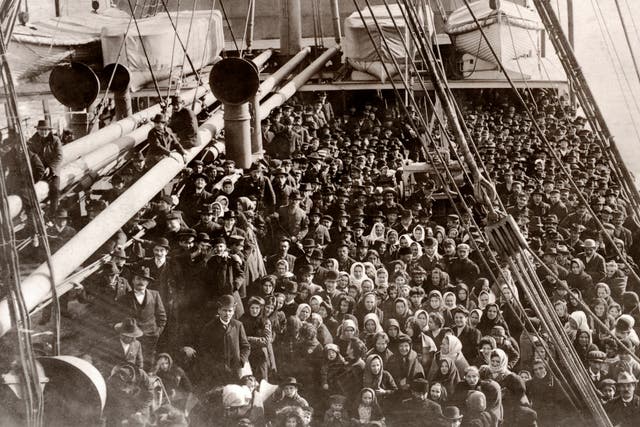
Attitudes and laws around U.S. immigration have vacillated between welcoming and restrictive since the country's beginning.
Updated: August 23, 2022 | Original: December 21, 2018

The United States has long been considered a nation of immigrants, but attitudes toward new immigrants by those who came before have vacillated over the years between welcoming and exclusionary. Thousands of years before Europeans began crossing the vast Atlantic by ship and settling en masse, the first immigrants arrived in North America from Asia. They were Native American ancestors who crossed a narrow spit of land connecting Asia to North America at least 20,000 years ago, during the last Ice Age.
By the early 1600s, communities of European immigrants dotted the Eastern seaboard, including the Spanish in Florida, the British in New England and Virginia, the Dutch in New York, and the Swedes in Delaware. Some, including the Pilgrims and Puritans, came for religious freedom. Many sought greater economic opportunities. Still others, including hundreds of thousands of enslaved Africans, arrived in America against their will.
Below are the events that have shaped the turbulent history of immigration in the United States since its birth.
January 1776: Thomas Paine publishes a pamphlet, “Common Sense,” that argues for American independence. Most colonists consider themselves Britons, but Paine makes the case for a new American. “Europe, and not England, is the parent country of America. This new world hath been the asylum for the persecuted lovers of civil and religious liberty from every part of Europe,” he writes.
March 1790: Congress passes the first law about who should be granted U.S. citizenship. The Naturalization Act of 1790 allows any free white person of “good character,” who has been living in the United States for two years or longer, to apply for citizenship. Without citizenship, nonwhite residents are denied basic constitutional protections, including the right to vote, own property, or testify in court.
August 1790: The first U.S. census takes place. The English are the largest ethnic group among the 3.9 million people counted, though nearly one in five Americans are of African heritage.
History Shorts: The Revolving Doors of Ellis Island1815: Peace is re-established between the United States and Britain after the War of 1812. Immigration from Western Europe turns from a trickle into a gush, which causes a shift in the demographics of the United States. This first major wave of immigration lasts until the Civil War.
Between 1820 and 1860, the Irish—many of them Catholic—account for an estimated one-third of all immigrants to the United States. Some 5 million German immigrants also come to the United States, many of them making their way to the Midwest to buy farms or settle in cities including Milwaukee, St. Louis and Cincinnati.
1819: Many of newcomers arrive sick or dying from their long journey across the Atlantic in cramped conditions. The immigrants overwhelm major port cities, including New York City, Boston, Philadelphia and Charleston. In response, the United States passes the Steerage Act of 1819 requiring better conditions on ships arriving to the country. The Act also calls for ship captains to submit demographic information on passengers, creating the first federal records on the ethnic composition of immigrants to the United States.
1849: America’s first anti-immigrant political party, the Know-Nothing Party forms, as a backlash to the increasing number of German and Irish immigrants settling in the United States.
1875: Following the Civil War, some states passed their own immigration laws. In 1875 the Supreme Court declares that it’s the responsibility of the federal government to make and enforce immigration laws.
1880: As America begins a rapid period of industrialization and urbanization, a second immigration boom begins. Between 1880 and 1920, more than 20 million immigrants arrive. The majority are from Southern, Eastern and Central Europe, including 4 million Italians and 2 million Jews. Many of them settle in major U.S. cities and work in factories.
1882: The Chinese Exclusion Act passes, which bars Chinese immigrants from entering the United States. Beginning in the 1850s, a steady flow of Chinese workers had immigrated to America.
They worked in the gold mines,and garment factories, built railroads and took agricultural jobs. Anti-Chinese sentiment grew as Chinese laborers became successful in America. Although Chinese immigrants make up only 0.002 percent of the United States population, white workers blame them for low wages.
The 1882 Act is the first in American history to place broad restrictions on certain immigrant groups.
1891: The Immigration Act of 1891 further excludes who can enter the United States, barring the immigration of polygamists, people convicted of certain crimes, and the sick or diseased. The Act also created a federal office of immigration to coordinate immigration enforcement and a corps of immigration inspectors stationed at principle ports of entry.
January 1892: Ellis Island, the United States’ first immigration station, opens in New York Harbor. The first immigrant processed is Annie Moore, a teenager from County Cork in Ireland. More than 12 million immigrants would enter the United States through Ellis Island between 1892 and 1954.
1907: U.S. immigration peaks, with 1.3 million people entering the country through Ellis Island alone.